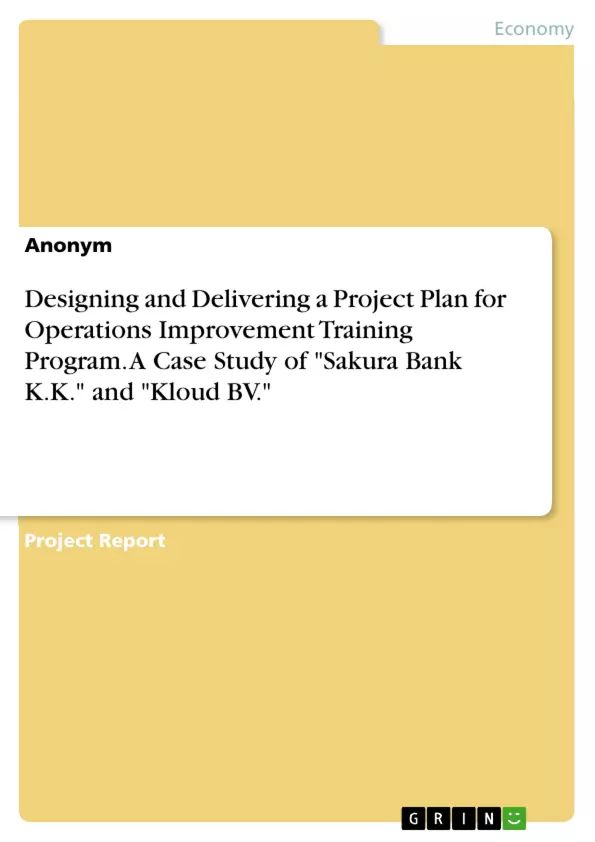The text presents a fictional case study of the design, development, and delivery of a project plan for the Sakura Bank K.K operations improvement training program. The project aims to equip the bank's managers with the latest operations improvements through a three-week executive training program in Osaka, Japan. The program consists of four phases, including pre-program activities, face-to-face training, program evaluation, and reporting. The project plan analysis focuses on four main attributes: project timing, costing, resourcing, and risks. The RACI matrix is used to identify key responsibilities for project team members. External and internal project risks are identified and prioritized using the Risk Priority Number. The project timing is analyzed using CPA techniques and Gantt charts, and crashing activities are recommended to meet the client's strict time plan. The project costing is calculated with and without crashing activities, and the margin is calculated at 20% of the total cost. The text concludes that by mitigating project risks, utilizing crashing activities, and distributing tasks to the right project team members, the operations improvement project can be a viable project with great potential for growth and future collaborations with the client.
Table of Contents
- Introduction
- Project Timing
- PERT Technique
- Critical Path Analysis
- Gantt Charts
- Project Costing
- Project pricing with without Crashing Cost Activity
- Project pricing with Crashing Costs Activity
- Project Resourcing
- Project Risk
- Internal Project Failure Risks
- External Project Failure Risks
- Risk Prioritising method RPN
- Mitigation Strategies
- Recommendations and Conclusion
- References
- Appendix
Objectives and Key Themes
The main objective of this report is to create a comprehensive project plan for an operations improvement training program for Sakura Bank K.K., delivered to the Managing Director of Kloud BV, a consulting and executive development firm. The report analyzes key project aspects, including timing, costing, resourcing, and risk management.
- Project Planning and Management
- Operations Improvement Training Program Design
- Project Costing and Budgeting
- Risk Management and Mitigation Strategies
- Project Scheduling and Time Management
Chapter Summaries
- Introduction: This chapter provides an overview of the project's purpose, including the client (Sakura Bank K.K.), the target audience (twelve managers), and the overall program structure. The report focuses on the key aspects of project planning and implementation.
- Project Timing: This chapter dives into project time management, outlining the use of formalized techniques like the Critical Path Analysis and Gantt Chart. These techniques are employed to assess project timelines and identify potential bottlenecks.
- Project Costing: This chapter explores the cost implications of the project, including both standard and crashed cost activity calculations. The chapter analyzes how crashing activities can affect the overall project cost.
- Project Resourcing: This chapter focuses on resource allocation and management for the project, ensuring sufficient human and material resources are available for project completion. It explores the process of optimizing resource utilization.
- Project Risk: This chapter addresses various risk factors, both internal and external, that could impact the project's success. It introduces the Risk Priority Number (RPN) method for risk prioritization and discusses mitigation strategies to minimize risk impacts.
Keywords
The core keywords and focus topics include project planning, operations improvement training, project timing, PERT technique, Critical Path Analysis, Gantt Chart, project costing, resource allocation, risk management, RPN method, and mitigation strategies.
- Quote paper
- Anonym (Author), 2022, Designing and Delivering a Project Plan for Operations Improvement Training Program. A Case Study of "Sakura Bank K.K." and "Kloud BV.", Munich, GRIN Verlag, https://www.grin.com/document/1348592



